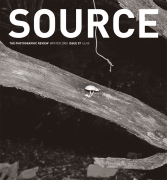Unit 2
Tom Lovelace
Issue 57 Winter 2008
View Contents ▸
I've always been fascinated by the industrial landscape; the object world of machines and devices. When I was growing up I spent a lot of time in that kind of environment. My father used to own a big factory and I spent time with him in evenings and weekends at the factory. Spending time in a factory that's not functioning you see a very different side to it. Manufactured objects have a specific function with a specific intention behind them, on paper they should be mundane things but I find them to be incredibly ambiguous. They have a clear purpose if they are used by the people who designed them but their visual appearance is secondary to their function.
When a machine is being built, the priority is that it achieves what it is being built for. Its visual identity is just formed as a byproduct. So I wondered what would happen if I built a series of industrial forms based on visual properties. Obviously, they don't have a function; I give the viewer the visual information and it's up to them to form their own ideas about what they may or could do.
With pen and paper I came up with designs. I was more interested in simple, minimal designs. Initially it didn't work because once I'd built these objects I was placing them in an industrial context and the forms weren't isolated. It was very obvious that I had put them in an old factory and they weren't believable things. I was shooting them in daytime and there was too much contextual information getting in the way of what I wanted to portray. So I decided to shoot them at night.
I wanted them to have an opening to lead the viewer in. I didn't want them to be a container like a box, they are supposed to look like a functioning thing. The front of the form is taller than the rear. They're life sized which is also important. I didn't want it to look like an installation of minimal fine art objects. I wanted them to be industrial objects.
They are made from a combination of wood and steel. The detail is crucial to make them believable, so I used bolts, coverhead screws, also some less obvious materials like hundreds of buttons that look like coverhead screws. These external markings suggest a relation with what is happening internally. The actual detail all interrelates, suggesting there is a core at the back. Finally they were all painted with metal-based paint to give them a sort of shine. They are a family of machines.
To try and locate them I put them on trolleys or tressles. They look like they are new things that are going to be moved somewhere, that they are in transition or that they are being built upon. I didn't want it to look like they were sitting in a corner disregarded. I wanted it to look like they were in play. On a purely aesthetic level the authentic objects, the tressles and the trolley are beautiful objects and they have their history marked upon them, whereas hopefully my objects look like they've just come out of production that day. Hopefully they give a sense of scale as well. I wanted the viewer to place themselves in the scene.
I want people to try and work out what they are but ultimately I like the idea that no one has ever seen them before. They are purely built for the camera and once they have been shot they are dismantled.








Other articles mentioning Tom Lovelace:






